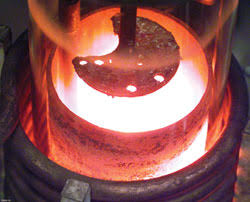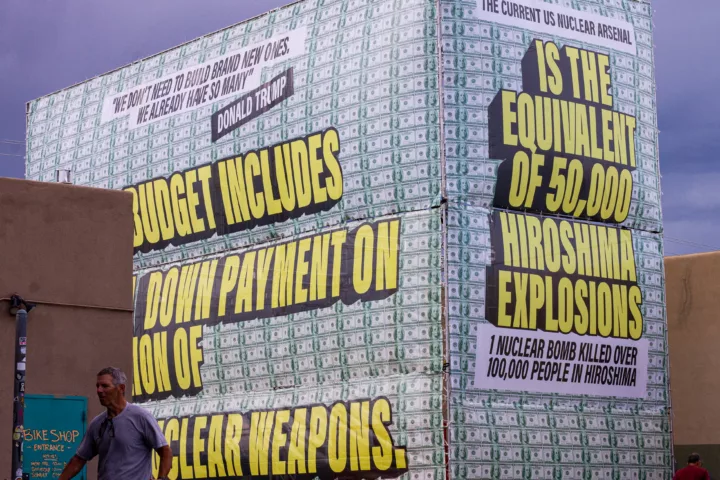
The National Environmental Policy Act (NEPA) is the landmark environmental law which requires executive agencies to give the public the opportunity to formally review and comment on major federal proposals. These talking points outline the history of the Department of Energy’s NEPA compliance on its various proposals concerning the production of plutonium pits (the fissile cores of nuclear weapons). The conclusion is that DOE’s semi-autonomous National Nuclear Security Administration (NNSA) is legally required to prepare a supplemental programmatic environmental impact statement (PEIS) on its current plan to expand plutonium pit production.
There are at least three reasons why NNSA must complete a supplemental programmatic environmental impact statement for expanded plutonium pit production:
1) Implementing regulations for the National Environmental Policy Act stipulate that “DOE shall prepare a supplemental EIS if there are substantial changes to the proposal or significant new circumstances or information relevant to environmental concerns…” 10. C.F.R. § 1021.314
2) As precedence, since 1996 there have been five programmatic environmental impact statements related to pit production and its expansion. It is legally unlikely that NNSA could implement its current plan to expand plutonium pit production without a new supplemental PEIS.
3) Now that NNSA is planning to produce more than 50 pits per year (or more than 80 pits under multiple shift operations), it is obliged by the 1998 court order to prepare a new PEIS.
A History –
June 6, 1989: A FBI raid investigating environmental crimes abruptly ends plutonium pit production at the Rocky Flats Plant near Denver. A federal judge seals the grand jury report and the U.S. District Attorney quashes indictments against the Rockwell Corporation (Rocky Flats’ manager) and responsible DOE officials.
1990: Pursuant to NEPA, the Natural Resources Defense Council (NRDC) won a court stipulation requiring DOE to complete programmatic environmental impact statements for its proposed post-Cold War reconfiguration of the nuclear weapons complex and its national cleanup program. DOE did neither until sued again.
November 1994: The Santa Fe, NM-based Los Alamos Study Group and Concerned Citizens for Nuclear Safety sued DOE over its plan to build and operate a facility designed to blow up surrogate plutonium pits in open-air tests at the Los Alamos National Laboratory (LANL) without a required environmental impact statement. In pre-litigation negotiations DOE acceded to the groups’ demand that it complete a nation-wide Stockpile Stewardship and Management Programmatic Environmental Impact Statement (SSM PEIS) for its nuclear weapons complex.
December 1997: DOE issued a formal SSM PEIS Record of Decision relocating plutonium pit production to LANL, but explicitly capped production at 20 pits per year (ppy), which remains in effect to today.
August 1998: After contesting the adequacy of the SSM PEIS, NRDC and 39 allied citizen groups won a court order requiring DOE to prepare a supplemental PEIS should it decide to produce more pits per year than analyzed in the SSM PEIS, which was “50 pits per year at LANL under routine conditions, and 80 pits ppy under multiple shift operations.” [1] That is the case now (see NNSA’s May 2018 decision below).
May 2003: NNSA released a draft (but no final) supplemental PEIS for a “Modern Pit Facility” (MPF), while explicitly referring to NRDC’s court order that “This MPF EIS is being prepared in part to satisfy that obligation.”[2] The MPF was designed to produce up to 450 ppy, a throwback to Cold War levels that NNSA never could justify.
October 2006: NNSA announced its intent to prepare a PEIS for “Complex 2030”, the nuclear weapons complex it planned by that year. It included a “Consolidated Plutonium Center” capable of producing up to 125 pits per year, explicitly linked to the production of new-design nuclear weapons called Reliable Replacement Warheads (RRWs). NNSA abandoned that proposal after congressional questioning and hundreds of negative public scoping comments.
November 2006: The JASONs (independent science consultants to the U.S. government) released a pit life study required by then-Sen. Jeff Bingaman at Nuclear Watch’s request. It concluded that pits have reliable lifetimes of at least 85 years, roughly double NNSA’s previous estimates. This dramatically undermined NNSA’s claimed needs for new-design RRWs and related expanded plutonium pit production, which Congress subsequently rejected.
June 2007 – June 2012: LANL produced 29 W88 pits to complete the production run that the 1989 FBI raid stopped at Rocky Flats. No further plutonium pit production has been scheduled for the existing stockpile because none is needed to maintain safety and reliability. Instead, LANL began tooling up for production of W87 plutonium pits for future so-called Interoperable Warheads to replace land-based W78 and sea-based W88 missile warheads.
May 2008: NNSA released a final Site-Wide Environmental Impact Statement (SWEIS) for Continued Operations at LANL in order to implement the proposed expanded pit production level of 50-80 pits per year at the site-specific level. Nuclear Watch and others argued that a decision to expand pit production should await the outcome of the Obama Administration’s 2010 Nuclear Posture Review. NNSA eventually agreed.
December 2008: A Record of Decision for NNSA’s Complex Transformation PEIS (redubbed from Complex 2030) designates LANL as the nation’s sole site for plutonium pit production, but kept it capped at 20 pits per year.
June 2013: Major operations at LANL’s main plutonium facility are suspended for over three years because of nuclear criticality safety issues. According to recent reports by the Defense Nuclear Facilities Safety Board, LANL has yet to fully resolve these nuclear safety issues, casting doubt on its ability to expand pit production.
December 2014: The FY 2015 Defense Authorization Act required NNSA to demonstrate the ability to produce 80 pits per year by 2030, conveniently delinking that requirement from what the existing stockpile actually needs.
May 2018: NNSA announced it plan to increase production at LANL to at least 30 pits per year while establishing redundant production at the Savannah River Site to at least 50 pits per year by repurposing the failed MOX Fuel Fabrication Facility. Estimated life cycle costs of NNSA’s chosen plan are ~$43 billion.
October 2018: Nuclear Watch New Mexico, Tri-Valley CAREs and SRS Watch write NNSA demanding a new PEIS for expanded plutonium pit production, requesting a response within 30 days. No response was received.
December 2018: NNSA’s congressionally required report W78 Replacement Program (W87-1) states the agency “is no longer planning for an interoperable warhead as previously conceived.” This is striking because: 1) Interoperable Warheads were central to NNSA’s “3+2 plan” that the agency claimed would transform the nuclear weapons stockpile;[3] and 2) the Interoperable Warheads were the programmatic driver for expanded pit production. NNSA now claims that even if new pits not are used in its proposed substitute for the W78 ICBM warhead (i.e., the new W87-1), expanded production would still be necessary for any unspecified life extension program that would follow it. NNSA has still not given the American taxpayer a concrete rationale for expanded plutonium pit production.
Jan. 2019: The Congressional Budget Office’s new Projected Costs of U.S. Nuclear Forces, 2019 to 2028 estimated “about $9 billion from 2019 to 2028 for expanded pit production capacity, although that estimate is very uncertain.”
January 2019: Nuclear Watch New Mexico, Tri-Valley CAREs and SRS Watch emailed NNSA General Counsel requesting a meeting to discuss a PEIS for pit production. NNSA’s head lawyer replied, “No meeting is called for.”
In sum, NNSA should prepare a new supplemental programmatic environmental impact statement for expanded plutonium pit production without delay. January 2019
These Plutonium Pit Production NEPA Talking Points are available here
[1] See court order at https://law.justia.com/cases/federal/district-courts/FSupp2/20/45/2423390/
[2] Draft Supplemental Programmatic Environmental Impact Statement on Stockpile Stewardship and Management for a Modern Pit Facility, NNSA, May 2003, https://www.energy.gov/sites/prod/files/EIS-0236-S2-DEIS-Summary-2003.pdf
[3] NNSA’s 3+2 plan involved three different Interoperable Warheads for land and sea-based ballistic missiles and one gravity bomb and one cruise missile warhead for the air leg.

